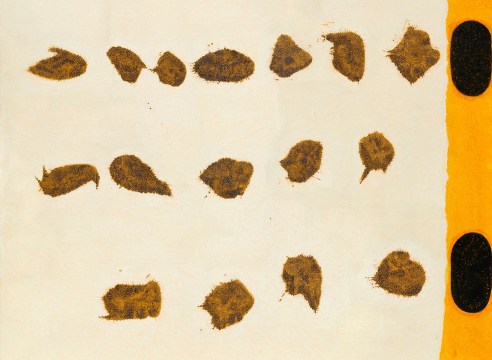
You have newly been selected winner of Finland’s State Award for Literature, making you the first Finnish artist to have ever received the State Award for both visual art and literature. Congratulations on behalf of the entire team at Galerie Forsblom!
1. In addition to writing fiction, you have made your mark in a number of creative fields, weaving effortlessly between visual arts, stage set design, costume design, directing, illustrating and curating. Where do you find inspiration for it all?
I'm less a believer in inspiration than in good old-fashioned 'field work' – in the power of sketching, studying and my own, ever-growing curiosity. I have discovered that working across different disciplines is not only a great source of spiritual growth,but also a veritable cornucopia of fresh ideas for my work. As it happens, these are the qualities I associate with the artists of the future.
2. Is there a connection between your books and paintings? How does it show if we compare your new book coming out this spring and your exhibition opening at Galerie Forsblom?
Since I began publishing fiction regularly in 2004, I have noticed that to a growing degree my art has become liberated of the burden of narrativity – it has moved in an increasingly non-narrative, near-abstract direction. Of course there are still literary references in my paintings, but not as many as there once were. Meanwhile, my books often provide detailed descriptions of the painting process, which can be quite challenging – and therefore intriguing – to fluently integrate in the storyline. The works in my forthcoming exhibition are only loosely linked to my new book. The core material in the exhibition – paintings, photographs and so on – tie in with the ‘vertical rivers’ theme that I have been working on over the past couple of years.
3.) In your previous exhibition at Galerie Forsblom, you drew a parallel between painting and photography. In doing so, you visualized the phases of the creative process from the initial perception to the completed work. Are these transitions also visible in your fiction?
Yes, quite often, actually. A certain chapter or an entire plotline might be based on a visual experience or even a fleeting impression that triggers an avalanche of ideas in my mind, which then find their way into the manuscript. There is a delicious cross-fertilization that occurs between my visual perceptions and my literary output. But the outcome isn’t always based on a visual cue; it can just as easily be an olfactory experience, or an auditory one. The entire creative process, whether it be painting or writing, is, for me at least, a process of summoning forth all five if not seven senses.
4. Do you choose your themes to match your medium, or do they come to you intuitively?
When I’m developing an idea, I’m not always sure whether the project will turn out to be a painting or a text. This becomes clear as the work unfolds. But it’s not self-evident at first. This is something I enjoy immensely, as it fuels my passion for discovery and shows how the creative process can sometimes utterly surprise the creator. For me personally, the journey to the finished work/painting/book is more important than the end result. I can always recall the sum of experiences that went into creating it.
5. Your fiction has a distinctly autobiographical feel to it. Does the same apply to your paintings, and if so, how?
I think the autobiographical element is stronger and easier to detect in my books. Of course every painting, video and photograph is autobiographical, because it is based on life and experience, and creating a work of art demands a certain intensity of presence. What is more, the autobiographicality of my books keeps changing with every new work. In fact they are constantly moving in more fictive, imaginary direction. But because I have only one imagination, not two, my books and paintings draw from the same pool of ideas. My paintings must accordingly be autobiographical to some extent, though this is less obvious than in my books.
6. You live in the South of France and Paris. The world is still reeling from recent shocking events in Paris. Do you think this will have an impact on your artistic practice?
Last Friday, while I was watching the news at home in Paris, I was struck by a strong feeling that it would be impossible for me to ever create anything after such a fanatical terrorist attack – there was no way I could ever write or paint again. I fathomed on a very deep level that everything I do, the core values embodied by my art, are directly in the firing line of ISIS and other fanatics. I felt thoroughly paralysed, or as if a limb had been amputated. After two days of inertia, I forced myself to get up and get back to work, perhaps not exactly the same way as before, but in search of something new. Now I feel I might have found it. Of course there are deadlines that force me to keep painting and writing. But when I stop and sit down at the end of the day, I feel a sense of heaviness – a feeling of collective concern and anxiety – weighing on my chest. Those among us who witnessed recent brutalities at close range in Paris will need a great deal of time before life truly gets back to normal. But as they say, work – in this case too – is the best therapy. But it has to be about proposing a dialogue, not navel-gazing.
